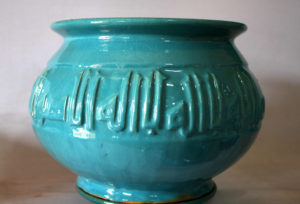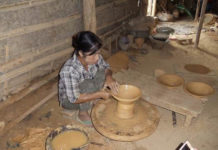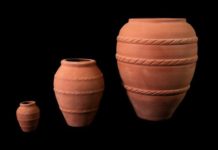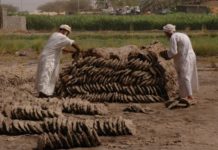
Each corner of Afghanistan has a regional tradition of artisanal ceramics, from simple sun-baked kitchen vessels to the celebrated polychrome tiles which clad the walls of the Friday Mosque of Herat.
One area which has seen a revival of its longstanding pottery tradition is Istalif, a village located on the Shomali Plain 50 kilometers north of Kabul. For four hundred years, the potters of Istalif gathered local clay and mixed it with vegetal matter to craft their earthenware vessels, which they shaped on kick-wheels. The families of Istalif have shared their expertise with the pottery school of the Turquoise Mountain Institute in Kabul, where, among others, master potter Abdul Matin Malekzada (the son of the local malik or headman of Istalif) teaches a new generation of Afghan ceramicists.
After the vessels are shaped on the kick wheel (or the tiles are formed in wooden moulds), they are left to air dry. Next, they are dipped in a quartz-based white slip and bisque-fired. After this, decorations are incised (traditionally, often by the female members of the family, working at home). Glazes are applied next. The most well-known is the vivid glaze known locally as ishkor, which is derived from the thorns of a bush native to the lower Hindu Kush mountain range. When combined with a small amount of copper oxide, it results in the vivid turquoise colour for which the pottery of Istalif is famed. Finally, the vessel is again fired in a kiln. There are multiple phases of firing as different glazes require different firing temperatures, with the entire process taking several days.
Using a combination of wood, electric, and gas kilns, the potters now fire their vessels at much higher temperatures. This results in stronger, more robust ceramics. The potters have also adapted their glaze materials to avoid any toxic ingredients.
Further reading
Coburn N. and E. Svensson. Rebuilding Afghanistan Pot by Pot: The Turquoise Mountain Foundation and the Potters of Istalif
Gascoigne, A.L. and R. Bridgman. Pottery from Jām: A Mediaeval Ceramic Corpus from Afghanistan, Iran: Journal of the British Institute of Persian Studies 48 (2010): 107-151.
Michelsen L.K. et al, Ferozkoh: Tradition and Continuity in Afghan Art. Doha: Bloomsbury Press, 2013.




